FAQ
- Bolivia climbing questions
-
Mallorca island and rockclimbing
- What are main specifics of rockclimbing trip to Mallorca
- Mallorca island impressions
- Rockclimbing safety Spain
- Mallorca climbing accommodation
- What season is possible for rockclimbing in Mallorca
- Transport accessibility of climbing sectors in Mallorca
- Active vacation in Mallorca
- Saint Anthony night in Mallorca
- Peru climbing questions
- Gear reviews
-
Safety in the mountains
- How NOT to climb the summit?
- Mountain navigation
- At the limit of possibilities
- Mountain thunderstorm
- Solo ascents and mountain trips alone
- Mutual responsibility in mountaineering
- Safety illusions in the mountains - a rope
- Independent team of two
- Mountain troubles
- Psychological problems in the mountains
- Health in the mountains
-
Elbrus questions
- Elbrus climbing gear
- Climbing Elbrus with children?
- Mount Elbrus location?
- Elbrus logistics
- How to get to Mount Elbrus?
- Elbrus German airfield?
- Elbrus difficulty grade
- 5 points beginner must know about Elbrus
- How to prepare for Elbrus?
- Are there avalanches on Mount Elbrus?
- Climbing Elbrus solo?
- Seasonality of climbing Mount Elbrus
- How much time climbing Elbrus takes?
- Clothes for Mount Elbrus?
- Pressure at the top of Elbrus?
- Elbrus air temperature
- Elbrus sightseeing
- How much to climb Elbrus
- Gear questions
- Mountaineering questions
- Mountain climbing training
-
Rockclimbing questions
- Rockclimbing gear
- How to choose your first rockclimbing shoes
- The hand power in roclcimbing
- What is Rockclimbing tours
- Non olymnic rockclimbing
- What is rockclimbing?
- Where do you climb?
- Where and when we organize our rockclimbing programs?
- What is rockclimbing?
- Rockcliming program class?
- Climbing motivation
- Horse riding tours
- Iceclimbing questions
-
Questions on the alpine programs
- What to climb in Morocco?
- Weekend summit climb
- Georgia 2023
- Pico Aneto - what is that mountain?
- Mountain programs format
- Mountain climbing food ration
- Queries on the alpine program climbing Mount Bazarduzu
- Queries on the Kamchatka alpine program climbing
- What is combined program?
- What is sightseeing program?
- What is pilot program?
- What programs you have of the medium complexity level?
- Basic expedition rations
- Prices for the mountain climbing programs
- Queries on the Mountain Course in Adyl Su valley
- Program complexity?
- Questions about MCS AlexClimb
- Questions related to trekking programs
Coca leaves
Coca leaves are not a drug
Read in Telegram in English
Leer en Telegram en Español
Climbing collection MCS AlexClimb in South America - here
The best news from a parallel universe
06/24/2023 ----------------During a trip in one of the remote mountain regions of Peru, a group of tourists from Russia consisting of 3 people, including a guide, was poisoned by an unknown plant substance and ended up in the hospital. The condition of the victims is stable, their lives are not in danger -------
Spoiler: "they were expecting a different effect" The result is not poisoning, but indigestion. All three enjoy the effects of a cleansing enema after the discomfiture of eating coca leaves.

Coca - the most famous plant in South America
In connection with this incident, and also in view of the many attempts to do the same in the tourist groups under my leadership, I decided to shed light on this topic from the point of my own experience. Perhaps the information listed below will help someone to avoid unjustified expectations and misunderstandings.
Perhaps I will not be mistaken if I call coca the most famous plant in South America. Due to the incredible popularity of the products made from this plant, many countries have significantly improved their economies. And humanity as a whole received a galaxy of famous drug addicts, whose work cannot be imagined without a close friendship with the white demon of the 19th and 20th centuries. Add to that the masterpiece of the commercial projects - the Coca-Cola drink, and we get a picture of the perfect integration of the Erythroxylum coca plant into the world of the modern civilization.

Small coca plantation in Bolivia
Coca is a nondescript and unremarkable bush 1.5-2 meters high with oblong juicy green leaves and red berries, growing along the entire upper border of the South American selva at the altitudes of 1800-2200 m in Peru, Bolivia, Argentina, Chile, Colombia, Ecuador. In many areas, this species are actively cultivated, which is not always approved by law, but may not be associated with any illegal purposes.
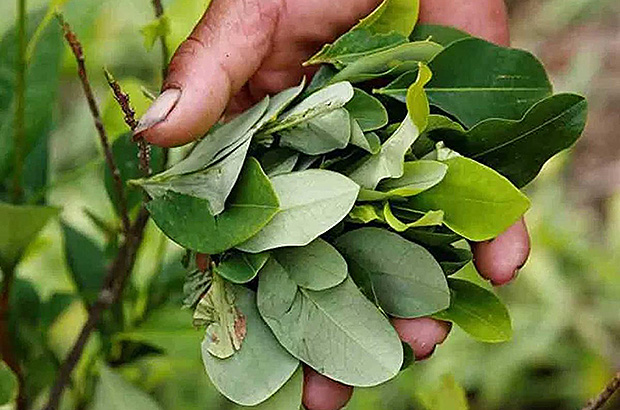
Coca leaves are harvested 4-5 times a year, one bush can produce a crop for 10 years
It is important to understand that coca leaves in their natural are not a drug. Only when their concentration is above certain (very significant) volumes, is it possible to use them for the production of cocaine. In countries where the problem is criminalized, coca cultivation is regulated at the legislative level, usually by limiting the amount of coca leaf production allowed. For example, in Colombia, the cultivation of coca bushes is prohibited in the amount of more than 20 bushes per person, in Peru and Bolivia there are regional restrictions on the production volumes, but in general, in small quantities and for private households, there are no limits.
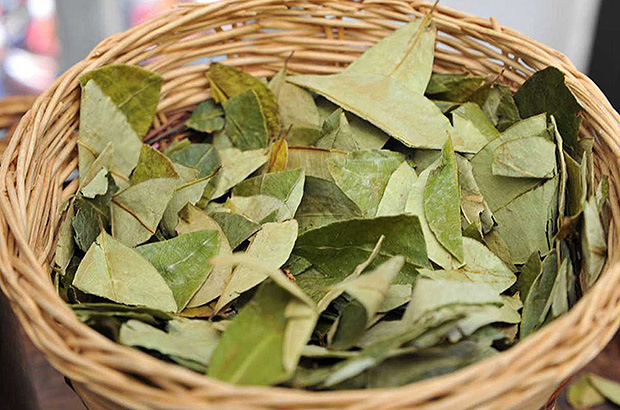
Serving form of coca leaves for making coca mate drink
However, using the coca plant to produce cocaine is merely the effect of a modern technological and cultural interpretation of the plant's ancient meaning. It should be noted that for more than 5000 years, the ancient civilizations of the Inca, Chavin, Quechua, Aymara, Huisca, as well as the natives tribes of the Amazon, did not guess to use coca plant for the production of any drug.
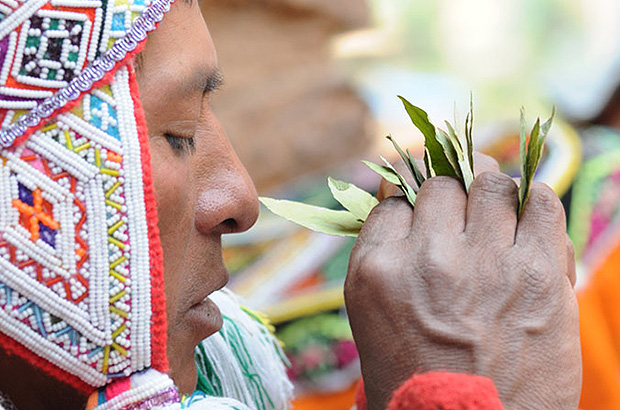
Coca leaves still have important symbolic meaning in many South American cultures
For all these ancient cultures, the coca plant had a very serious everyday, cultural and ritual significance for many millennia. Artifacts of antiquity that have come down to us speak of how important and integral the use of coca leaves was 3-5000 years ago.
The first indications of the ritual significance of the coca leaves have been discovered in archaeological studies of the ancient South American cultures at the horizons back to 6000 BC. Judging by the discovered artifacts, the coca plant was of great religious importance, used in basic rituals, medicine and decorative arts. To this day, in the remote mountain regions of Peru and Bolivia, the traditions of using coca leaves in the rituals associated with the worship of Pacha Mama (Mother Nature), have been preserved.
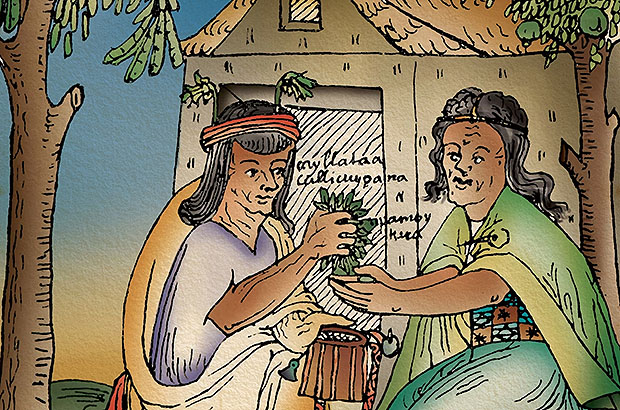
The traditions associated with using coca leaves are rooted in the distant past
Products with some ingredients derived from coca leaves (or simply branded with a name or image of the plant) are very popular in many South American countries in these days. In the stores in Peru, Bolivia or Ecuador, you can buy lollipops, cookies, even shampoos with coca leaf extract.

Shampoo with coca leaf extract
Coca mate - herbal tea, also sold in the most stores in Peru, Bolivia and Ecuador, is not something special, which goes beyond the norms of the usual daily grocery set. The taste of coca-mate resembles a weak herbal tea without caffeine, this drink has no obvious stimulating or calming effect.

Factory packaged Coca mate in the form of tea bags
Another popular form of coca leaves consumption is the brewing of whole coca leaves - neither the taste nor the effect of this drink differs from the packaged form. At any food market or grocery store, you can see oblong plastic bags, usually of the green color, containing 100-200 g of dry leaves similar to laurel leaves. The cost of one bag is no more than 1 USD - if you use the leaves for making coca mate, this amount is enough for a couple of weeks of the evening tea drinking.

Herbal drink coca mate
In the mountain regions of Peru and Bolivia, the Quechua Indians use coca leaves as a mild stimulant. Dry coca leaves are chewed, spitting out the resulting saliva. The chewed mass is not swallowed, stretching its use for many hours. I would call the effect of such chewing of the coca leaves rather psychological - for a person who is not accustomed to use coca leaves in this form, no noticeable effects will occur. (unless, of course, of you eat a whole bag of the dry leaves, as happened with the poor tourists from the header). However, even in this case, the narcotic effect was not achieved, it all ended in the banal diarrhea.
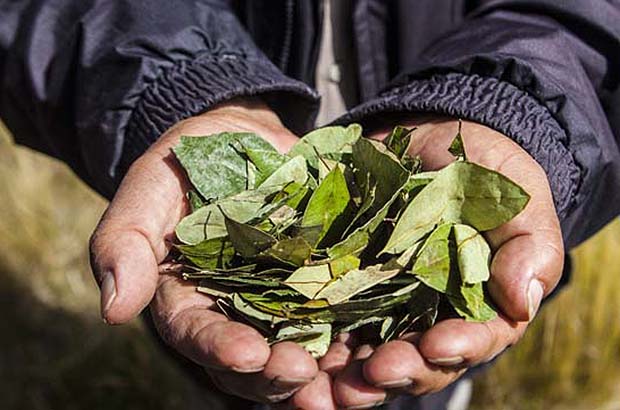
Dried coca leaves
It is generally accepted that the use of coca leaves in any form has medical significance, helps with various inflammatory processes in the body. It improves immunity and the ability to endure physical stress, including high-mountain ones. From my experience I can note that for 15 years of my work in Peru as a tourist guide, I never have seen any pronounced effect from coca-mate or chewing coca leaves. Perhaps this effect is based on the traditional ideas, perhaps it is due to the psychological attitudes and confidence in obtaining the expected effect to the body.
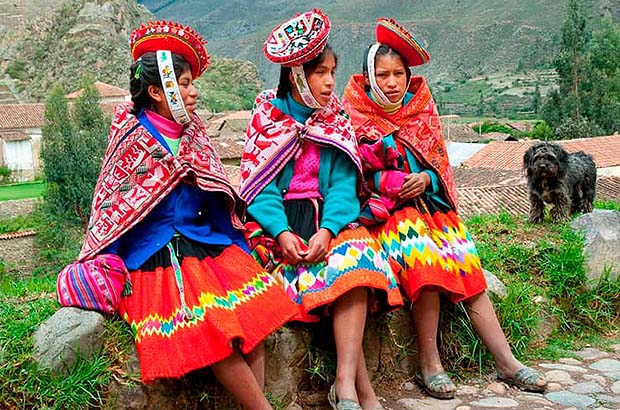
Village beauties in the traditional Bolivian attire
As for the fact that the Indians live an active lifestyle and work productively at altitudes of more than 4000 m due to the use of coca leaves - I am deeply not sure that this statement is true. For the natives of the Andean highlands, coca leaves are part of their common ancient culture, and also one of the few entertainments available on a budget. In fact, the Quechua Indians do not need any additional help in adapting to mountain conditions, since, having lived in the highlands throughout all their history, dating back to a distant, foggy past, this nation has a genetic immunity to any manifestations of hypoxia.
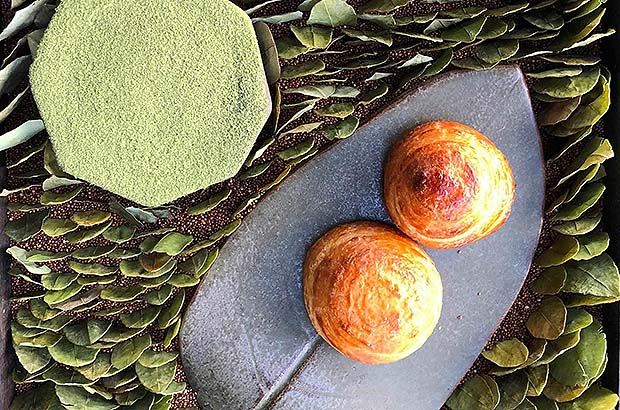
Decorative use of coca leaves for serving dishes of the national cuisine of Peru
The question is also quite often asked - is it possible to carry coca leaves in luggage on the international flights?
So to speak. This product is not a drug. Further, everything depends on the position of the customs, local laws on the transportation of the products of the organic origin and other restrictions.
It is absolutely certain that coca leaves cannot be subject to the rule of law relating to the transport of drugs. However, to reduce the risk of unforeseen complications with the customs, I would not take this product with me in the hand made packaging. As for factory packaged coca mate and other thematically branded products, there is nothing but a picture in them, in fact it is the same as having a bottle of Coca Cola with you, which, theoretically, can contain some coca extract.

Beverage that officially contain coca leaf derivative
By the way, the Coca Cola Company for more than a hundred years has been the only commercial enterprise that has the full legal right to purchase, internationally transport and process coca leaves in any volume. This fact clearly demonstrates that the legality of this product depends entirely on its further use.
I thank everyone who got to the end of this text for their patience and sincere interest in the subject of the conversation! I remind you that the main message of this text is a literal interpretation of the South American position - La hoja de coca - no es droga (coca leaves are not a drug).
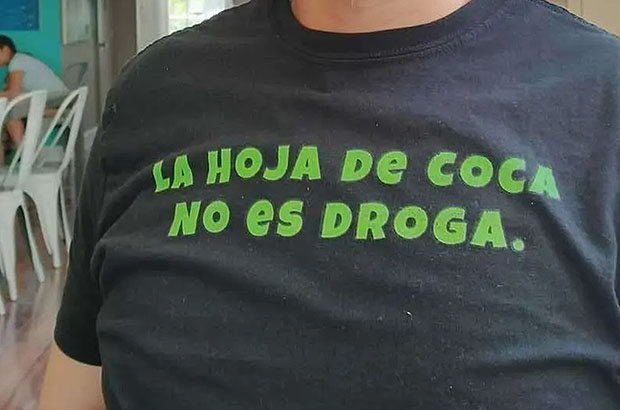
La hoja de coca - no es droga (coca leaf is not a drug)
So, to the chagrin of the thrill-seekers - do not expect any effect from these leaves other than diarrhea. However, the tastes may differ - diarrhea can also happen in an acute and unexpected form.
Text by Alex Trubachev
Professional guide in South America
MCS EDIT 2023
Our Principles
AlexClimb Rule #1 - Safety First
From the very beginning of our activity, here nearly 16 years, the first Principle of work of School of mountaineering and rock-climbing of MCS AlexClimb is the Safety Priority. On the basis of this Principle all process of training is based, all programs and rounds are developed and carried out only within this main principle. We consider that at professional approach to development of programs, at personal discipline and correctly put motivation - occupations by mountaineering and rock-climbing are COMPLETELY safe. And from the return - all troubles and accidents in our sport come from nonprofessionalism, from ignorance or neglect by elementary standards of safety, from irrational motivation, from revaluation of own forces and opportunities. All these prerequisites we COMPLETELY EXCLUDE in our work - ours Rock-climbing, Ice climbing and Mountaineering are based on one Principle - the Safety Priority. In rock-climbing, mountaineering and ice climbing, the Priority of Safety of MCS AlexClimb-is your personal security and comfort irrespective of, than we are engaged - we train muscles and we work technology of the movement in the sports hall and on the rock climbing wall, we make the way through snowstorm to top or we relax on golden sand of the Caribbean beach after hot day of trainings on rocks. The Safety priority - the main credo of School of mountaineering and rock-climbing of MCS AlexClimb.
AlexClimb Rule #2 - Leave No Trace
Closely interacting with Nature, working with the active programs in mountains, woods, lakes and rivers, we perfectly understand the importance of carefull and respectfull bahavior towards the Nature, for its resources. From the very beginning of our outdoor-activity we adopted rules of Leave No Trace technique - the standard of behavior of the person accepted in all the civilized world in relation to environment and especially - to the wild nature. After all on the relation of people to the nature near which they exist, itself can draw dalekoidushchy conclusions on the relation of these people to... Where and as we didn't travel - we don't reserve any garbage, we try to reduce whenever possible our influence on environment to a minimum. We clear earlier zagryazyonny tourist parking of the left garbage, we take out and we take out to utilization places that to us other people left there. We consider that only thus, at personal individual consciousness of each citizen, each tourist, climber or autotraveller, we will be able to keep the nature surrounding us in its state, natural, suitable for life, - in it pledge of the healthy future for ourselves and our children.





